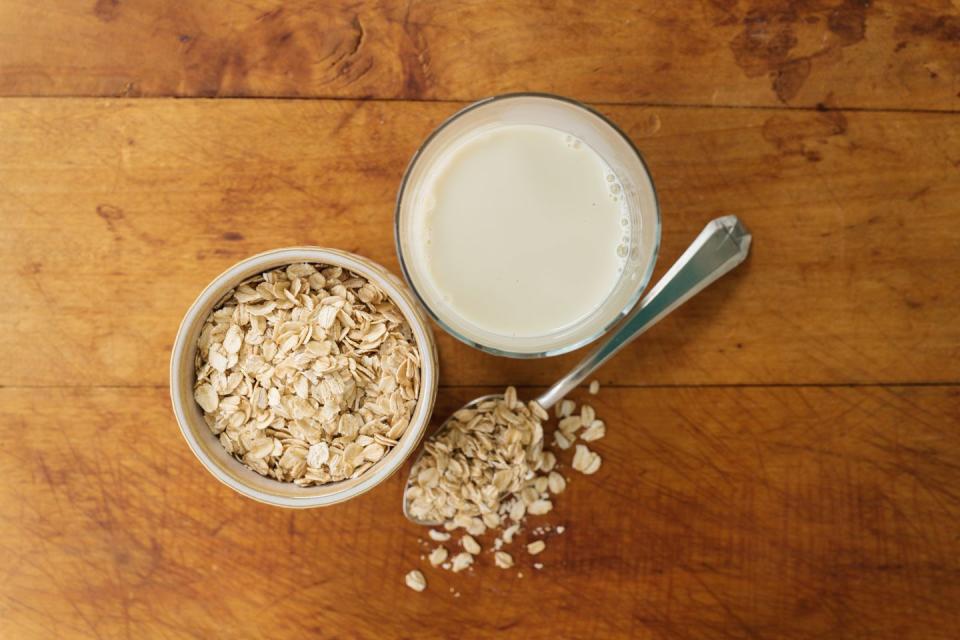Is oat milk the solution to good health and sustainability?

Plant-based milk has seen plenty of innovation in recent years, but oat milk is almost certainly the cream of the crop. Its mild, creamy flavour and dairy-like consistency is a winning combination for anyone looking to trade cow’s milk for a planet-friendly alternative. Plus, oat milk doesn’t separate in hot drinks like other plant milks (almond and coconut milk, we’re looking at you).
However, several questions remain. How healthy is oat milk, really? What are the benefits? Is it actually good for the planet, or is that just clever marketing? And crucially – how does it stack up against the white stuff? With input from nutritionist Jenna Hope we peeled back the lid on oat milk’s nutritional credentials to find out whether the plant-based drink deserves a place in your fridge:
How is oat milk made?
Oat milk is a plant milk derived from – you guessed it – whole oat grains. First, the grains are milled to break apart their outer hull. Then the grains are stirred into warm water, like a very large porridge, and ground down to form a thick mixture. Enzymes are added and the concoction is heated to form the oat milk base.
From there, the solids and liquids are separated, and fortifying vitamins and minerals such as calcium, B vitamins and vitamin D are added to the liquid. Then, the fortified liquid is typically pasteurised – or undergoes some other kind of heat treatment – to extend the shelf life before bottling. Voila! You have oat milk.
Oat milk nutrition
So, what’s in a standard glass of oat milk? The total macro and micronutrient content varies from brand to brand, depending on how they process their oats and what they choose to fortify the resulting milk with. The following nutritional information refers to 100ml of Oatly’s Whole Oat Drink, with percentage values for your Recommended Daily Amount (RDA):
57 calories
2.8 g fat (0.3 saturated)
6.6 g carbohydrates (4.1g sugars)
0.8 g fibre
1 g protein
0.10 g salt
50 μg vitamin D (30% of your RDA)
0.21 mg vitamin B2 (15% of your RDA)
0.38 μg vitamin B12 (15% of your RDA)
151 mg potassium (7.5% of your RDA)
120 mg calcium (15% of your RDA)
Stacked up against whole milk, oat milk contains around the same amount of calories, around one third of the protein, less total fat, far less saturated fat, and more carbohydrates (although fewer simple sugars than cow’s milk), with the added benefit of gut-healthy soluble fibre.

How healthy is oat milk?
Oat milk doesn’t contain the same nutrients you’d get from eating a bowl of oats, due to the way it’s processed. However, it does have plenty of healthful attributes. ‘Oat milk brands that are fortified with micronutrients and contain no added sugar can be a great alternative to dairy milk,’ says Hope. It’s typically fortified with calcium and vitamin D, which are essential for bone health. Calcium is the foundation of your bones – it’s the mineral used to form them – but your body doesn’t absorb it very well without a dose of vitamin D, so these nutrients really do go hand-in-hand.
Oat milk often also contains B vitamins, such as riboflavin (vitamin B2) and vitamin B12. These vitamins are water-soluble, which means your body doesn’t store them – you have to get them though your diet. They play a vital role in maintaining your health. Vitamin B2 helps convert food into energy and also acts as an antioxidant, while B12 is essential for neurological function and also helps make red blood cells and DNA.
Additionally, oat milk contains beta-glucans, a type of dietary fibre that can reduce your risk of heart disease. They form a gel-like substance inside your gut and binds to cholesterol and reduce its absorption. ‘Beta-glucans have been associated with a reduction in cholesterol,’ says Hope. ‘Three grams of beta-glucans daily is associated with significant reductions in cholesterol.’ In a study by the University of Lund, men who drank 750ml of oak milk daily reduced their total blood cholesterol by three per cent, and saw their ‘bad’ LDL cholesterol drop by five per cent. Beta-glucans are also prebiotic, which means they stimulate the growth of ‘good’ bacteria in your gut.
Oat milk is particularly beneficial for those with dietary restrictions. Since it’s made from little other than oats and water, oat milk is vegan, lactose-free, soy-free, nut-free, and just about every other ‘-free’ you can think of. It’s technically gluten-free, although take care if you have coeliac disease, since some oats are processed in the same factories as gluten-containing grains. Some commercial oat milk brands are made with certified gluten-free oats, but you should always check the label if you’re sensitive to gluten.
Is oat milk better for the environment?
By its very nature, dairy milk is always going to be more environmentally intensive than faux-milks. After all, cows require swathes of land and food – and therefore fertilisers and pesticides – all of which contribute to global warming. Their manure emits nitrous oxide, a climate pollutant that is 310 times more powerful than carbon dioxide.
Cup-for-cup, oat is the eco-friendliest option by far. Oat milk requires 80 per cent less land than dairy milk, and 15 times less water. For every litre of dairy milk produced globally, 3kg of greenhouse gases – mostly methane, which is 84 times more potent than carbon dioxide – are sent skywards. By comparison, oat milk production barely registers, contributing significantly less carbon dioxide (around 0.4kg per litre) and, unlike dairy, zero methane.

The downsides of drinking oat milk
Oat milk is healthy, but there are some potential downsides to watch out for. For one, most oat milk isn’t certified gluten-free, so if you have trouble digesting gluten, it’s worth checking the label before you buy – or you may be in for an unpleasant surprise. Clever marketers can make oat milk cartons appear more nutritious than they actually are, so watch out for innocuous phrases like ‘original’ or ‘plain’, because they may well contain added sugar. Likewise, ‘barista’ editions contain oils that make the texture creamy.
‘Oat milk is higher in natural sugars than other milks such as almond, coconut and soy,’ says Hope. ‘As a result, portion control is key. Since oat milk tends to be quite creamy, it can be combined with water to reduce total sugar intake. Oat milk is also higher in calories, and therefore, for individuals looking to reduce their total energy intake they may benefit from switching to another plant milk.’
While oat milk is generally safe for babies and children to drink, it lacks several nutrients that are essential to their development, so it isn’t a suitable replacement for breast or cow’s milk. Make sure you speak to a paediatrician before introducing any plant-based milk to your child. It’s also more expensive than cow’s milk, which isn’t ideal if you're on a budget. You can make oat milk yourself at home, there are plenty of recipes online – all you really need is a blender and a fine mesh strainer – but remember, it won’t have the fortified vitamins and minerals that commercial oat milk contains.
How to shop for the healthiest oat milk
With a bit of know-how, you can enjoy oat milk as part of a healthy, balanced diet. When you’re shopping the faux-milk aisle, always choose unsweetened where the option is available to you. ‘Where possible, opt for oat milk that does not contain added sugars,’ says Hope.
‘I also recommend choosing brands that are fortified with calcium, Vitamin B12 and vitamin D as a minimum. Some brands also now fortify their oat milk with iodine too, which is key to supporting a healthy thyroid function.’ If you can, choose organic oats – regular oats are often sprayed with glyphosate, a chemical weed killer that is categorised as ‘a probable carcinogen for humans’ by The International Agency for Research on Cancer.
Last updated: 29-10-20
You Might Also Like


